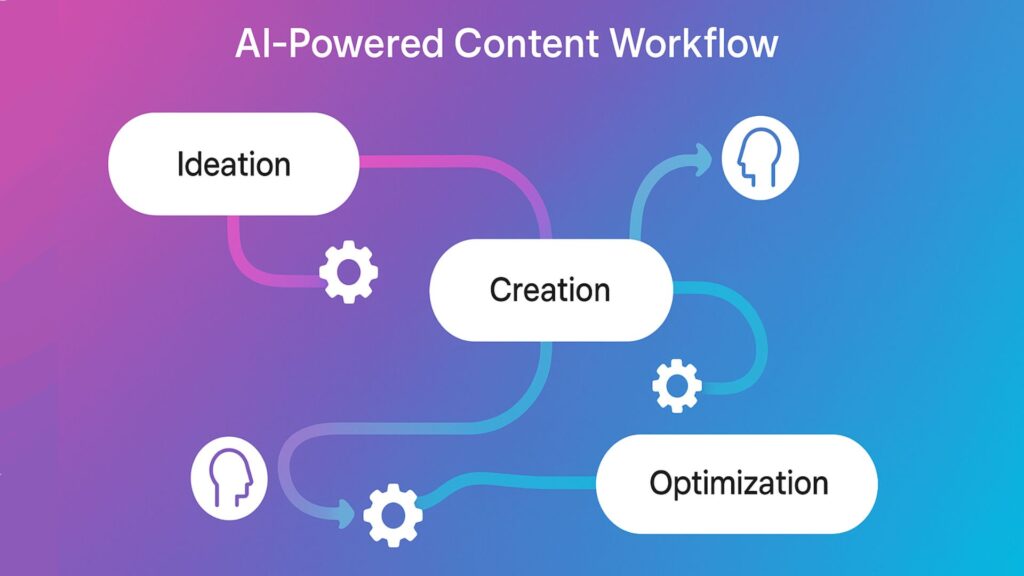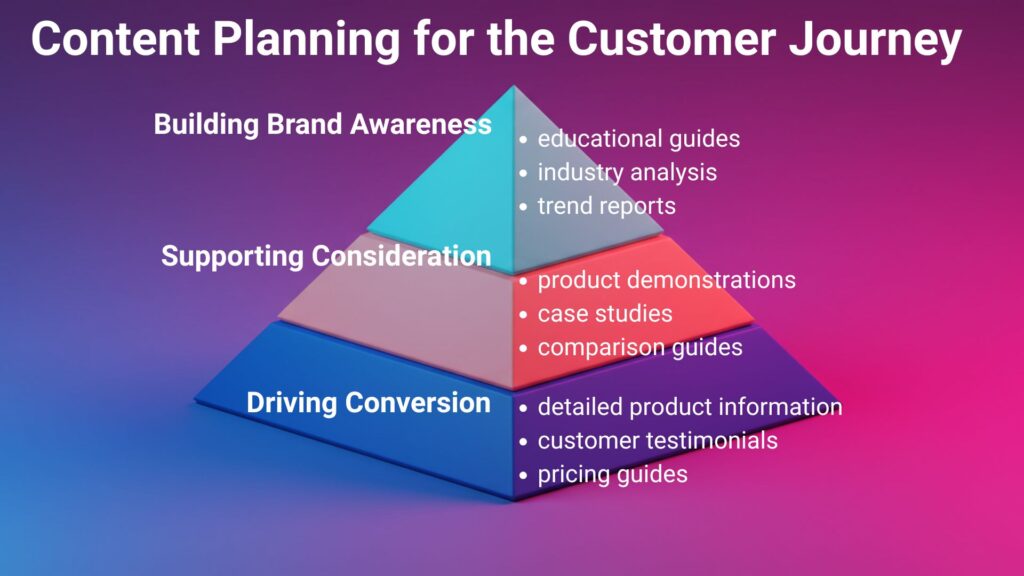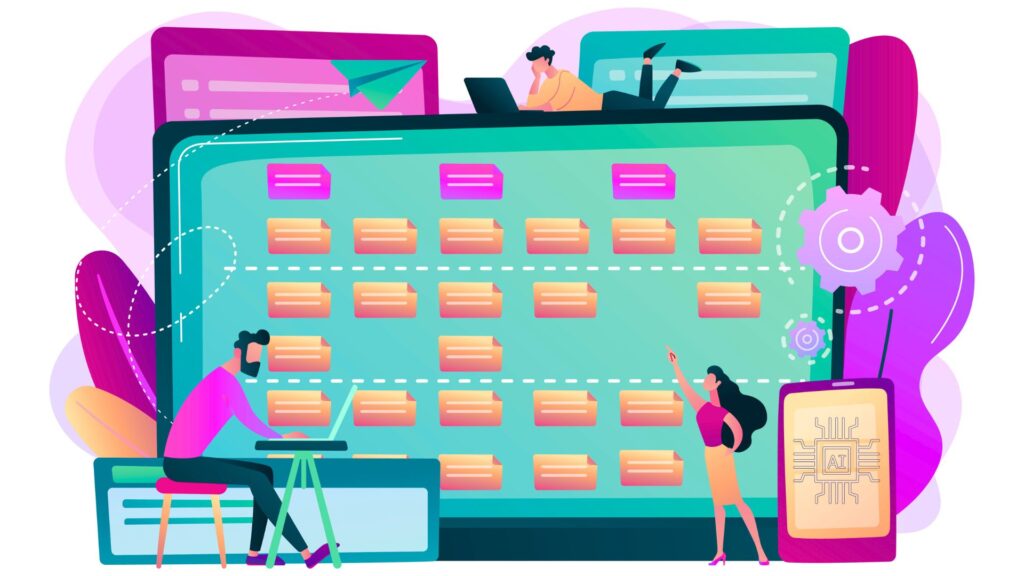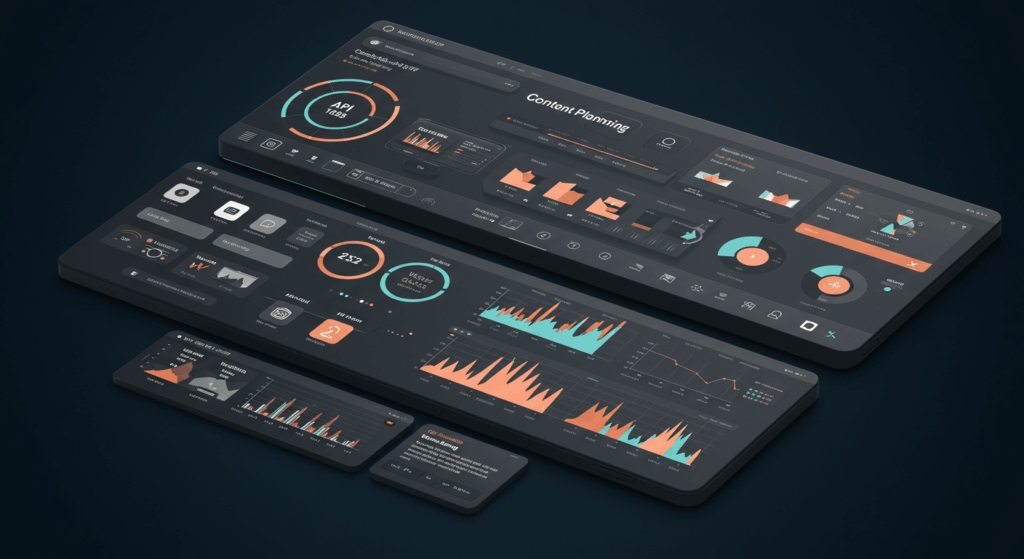Modern content planning success demands AI-powered workflows and data-driven automation that adapt strategies in real time based on performance insights.
- Strategic frameworks must integrate intelligent workflow automation, performance prediction, and adaptive optimization systems.
- Operational efficiency dramatically improves when teams combine human creativity with AI-assisted planning and automated task management.
- Measurable results show significant gains in asset creation speed, team productivity, and campaign launch velocity for organizations using intelligent planning systems.
- Competitive advantage goes to teams that seamlessly blend strategic thinking with automated workflows and continuous performance optimization.
The key is implementing systematic approaches that eliminate manual bottlenecks while maintaining creative control and strategic alignment.
Let’s be honest: what passed for great content planning just a few years ago now feels about as relevant as a 2010 social media strategy. The game has changed completely. Rather than competing on creativity alone, modern content teams are competing on operational intelligence, workflow efficiency, and the ability to instantly adapt strategies based on performance data.
Most organizations have dedicated content teams these days, but here’s the kicker—they’re usually running on fumes, juggling way too much with way too few people. The most successful teams are now integrating AI-powered automation into their workflows. The difference between content teams that thrive and those that struggle often comes down to having a systematic approach to content planning that evolves with technology and audience expectations.
Content planning creates a detailed roadmap to success. It considers the goals you have in mind, lays out the framework for meeting them through your assets, and creates a structure for developing each piece of content. But in 2025, effective content planning encompasses intelligent workflow automation, performance prediction, and adaptive strategy optimization that modern marketing platforms enable.
What is Content Planning?
Think of content planning as your master blueprint. It’s how you figure out what you’re creating, where it’s going, and how you’ll make sure it actually performs once it’s out in the world. Teams follow processes for developing ideas for content pieces, determining the channels they will support, defining specific formats and goals, and establishing the creative stakeholders responsible for production.
Today’s content planning isn’t just about editorial calendars anymore. You need three things working together: a solid strategy, smooth workflows, and the data smarts to know what’s actually working. While traditional approaches focused primarily on editorial calendars and publishing schedules, today’s content planning encompasses the entire content lifecycle, from initial concept through performance analysis and optimization.
For example, a technology company launching a new product might develop a content plan that includes blog posts for SEO visibility, video content for social engagement, interactive demos for lead generation, and case studies for sales enablement. The process would define not only what gets created and when, but also how AI tools will assist in creation, how performance data will inform iterations, and how workflows will adapt based on real-time feedback.
The creative brief for each content piece would outline goal alignment, target audience specifications, keyword and topic requirements, distribution channel optimization, AI-assisted creation parameters, performance tracking mechanisms, and conversion pathway integration. This comprehensive approach ensures that every asset serves a strategic purpose while operating within an efficient, automated workflow system.
Why Do You Need a Content Plan in 2025?
The primary goal of a content plan remains ensuring assets are produced in a timely and consistent manner while aligning with business objectives. However, the stakes have risen. Modern audiences expect personalized, relevant content delivered through their preferred channels at precisely the right moments in their buyer journey.
Companies that get serious about structured content planning? They’re seeing real results—faster launches, better resource use, and content that actually moves the needle. They achieve faster deployment through streamlined workflow automation, better resource allocation via predictive planning tools, and improved performance through data-driven optimization.
Clear Objectives and Strategic Alignment
A comprehensive content plan provides clear direction for every project and establishes measurable success criteria. Decision-makers can confidently delegate work to teams knowing that outputs will align with objectives. This alignment becomes even more critical when AI-powered content operations are involved, as automated systems require clear parameters to function effectively.
Accelerated Production Through Automation
Planning content parameters in advance enables faster, more accurate delivery through workflow automation. Modern content planning incorporates AI-assisted ideation, automated asset creation, and intelligent routing systems that eliminate bottlenecks. Teams can move from concept to publication faster while maintaining quality standards.
Enhanced Acquisition and Engagement
Strategic planning supports audiences throughout their complete customer journey. Building comprehensive content plans gives organizations visibility into their pipeline from initial awareness through final conversion. Understanding content balance across funnel stages helps identify gaps and opportunities for optimization, particularly when combined with intelligent content lifecycle management.
Improved Creative Efficiency
Content teams with robust planning frameworks and effective templates find it easier to develop ideas and produce high-quality content quickly. Modern plans serve as frameworks for conceptualizing new assets while providing AI-assisted guidance for format selection, channel optimization, and performance prediction.
What’s the Difference Between Content Planning vs. Content Strategy?
People throw around ‘content strategy’ and ‘content planning’ like they’re the same thing, but they’re really not. Understanding the difference is key to making both work effectively.
Content strategy defines the overall approach to delivering audience experiences. It establishes what channels your organization uses for communication, outlines marketing objectives for each channel, and sets high-level goals for content performance. Strategy provides the foundational framework that guides all content decisions.
Content planning translates strategy into actionable workflows and specific asset development processes. It begins production with a clear understanding of intent, expected outcomes, and distribution mechanisms. Planning also includes performance monitoring, optimization processes, and feedback loops that inform future strategy adjustments.
The most effective content operations seamlessly integrate strategy and planning. All plans must align with objectives while ensuring adequate coverage across channels and audience segments. Organizations that identify and resolve gaps between planning and strategy achieve increased personalization capabilities, accelerated output scaling, and streamlined production processes that require fewer revision cycles.
Content Planning vs. Campaign Planning
Content planning and campaign planning serve complementary but distinct purposes within marketing operations:
Campaign planning focuses on audience targeting, messaging coordination, channel selection, and launch timing. It involves analyzing channel access, evaluating available resources, and ensuring campaigns don’t overextend organizational capabilities or channel capacity.
Content planning produces the specific assets that power campaigns. While content contributes to campaign success, the planning process itself doesn’t dictate campaign strategy or execution parameters.
Organizations typically emphasize either campaign or content planning as their primary decision-making framework, though the most successful teams integrate both approaches.
How Can You Implement AI-Powered Content Workflows?
AI is about much more than changing content planning—it’s completely transforming it. And honestly? It’s one of the biggest breakthroughs we’ve seen in how marketing teams actually get work done. Agentic AI systems can autonomously handle complex, multi-step planning processes, from initial ideation through performance optimization.

Modern AI-powered workflows typically include several sophisticated components working in coordination:
Intelligent Content Ideation
AI systems analyze audience behavior patterns, competitive content performance, and trending topics to suggest ideas that align with objectives. These systems consider factors like search volume, engagement potential, and conversion probability when recommending topics and formats.
Advanced platforms can generate complete content briefs including target audience specifications, key messaging points, optimal formats, and distribution strategies. This automation dramatically reduces the time content teams spend on initial planning while improving strategic alignment.
Automated Workflow Management
AI agents can orchestrate entire content production workflows, automatically routing tasks to appropriate team members based on availability, expertise, and workload. These systems monitor progress, identify potential bottlenecks, and suggest optimizations in real time.
Workflow automation capabilities include intelligent task prioritization, resource allocation optimization, deadline management, and quality assurance. Teams report significant productivity improvements when AI handles routine workflow management tasks.
Performance Prediction and Optimization
Sophisticated AI models can predict content performance before publication based on historical data, audience behavior patterns, and content characteristics. Teams can optimize content strategies proactively rather than reactively.
Real-time optimization systems continuously monitor content performance and automatically adjust distribution strategies, messaging, and targeting parameters to maximize engagement and conversion rates.
What Should a Content Plan Include in 2025?
Here’s the challenge: today’s content plans need to handle way more complexity than before, but they still have to make sense to everyone on your team—from the CMO to the newest content writer. The most effective plans incorporate traditional planning elements with AI-enhanced capabilities and performance intelligence systems.
Foundation Elements
Goal Definition and Measurement: Specific, measurable objectives tied to business outcomes, with AI-powered tracking systems that provide real-time performance insights and optimization recommendations.
Audience Intelligence: Detailed persona development enhanced by behavioral analytics, predictive modeling, and dynamic segmentation that adapts based on engagement patterns and conversion data.
Competitive Analysis: AI-powered competitive intelligence that monitors competitor strategies, identifies content gaps, and suggests differentiation opportunities.
Content Architecture and Production
Content Taxonomy and Classification: Systematic organization frameworks that enable AI systems to understand content relationships, suggest optimization opportunities, and automate distribution processes.
Format Strategy and Multi-Modal Planning: Comprehensive approaches that address video, audio, interactive, and text content while considering platform-specific requirements and audience preferences.
Creation Workflows and Automation: End-to-end production processes that integrate human creativity with AI assistance for ideation, creation, editing, and optimization.
Distribution and Performance Optimization
Channel Strategy and Automation: Multi-channel distribution plans with automated publishing, cross-platform optimization, and performance tracking across all touchpoints.
Performance Intelligence Systems: Real-time analytics that provide actionable insights, identify optimization opportunities, and inform future decisions.
Feedback Loop Integration: Systems that capture audience feedback, performance data, and market changes to continuously refine content planning strategies.
What Are the Types of Content Planning for Different Funnel Stages?
Effective content planning requires understanding how different content types serve various stages of the customer journey. While formats continue evolving, the fundamental framework of top-funnel awareness, mid-funnel consideration, and bottom-funnel decision remains relevant.
Each content category requires distinct planning approaches, success metrics, and optimization strategies. Modern systems can automatically categorize content by funnel stage and optimize distribution accordingly.

Top of the Funnel (TOFU): Building Brand Awareness
Top-of-funnel content focuses on educating potential customers about problems, solutions, and industry trends. This content typically features broader topics designed to attract and engage audiences who may not yet be actively evaluating solutions.
TOFU content planning emphasizes search engine optimization, social media shareability, and thought leadership positioning. AI-powered systems can identify trending topics, optimize content for search visibility, and suggest formats that maximize organic reach.
Successful TOFU content includes educational guides, industry analysis, trend reports, and problem-focused content that establishes expertise without being overly promotional.
Middle of the Funnel (MOFU): Supporting Consideration
Middle-of-funnel content helps prospects evaluate solutions and understand key differentiators. This content provides more specific information about approaches, methodologies, and solution characteristics.
MOFU content planning focuses on demonstration, comparison, and education that builds trust while showcasing unique value propositions. AI systems can personalize content recommendations based on prospect behavior and engagement patterns.
Effective MOFU content includes product demonstrations, case studies, comparison guides, and solution-focused educational material that helps prospects make informed decisions.
Bottom of the Funnel (BOFU): Driving Conversion
Bottom-of-funnel content supports final purchase decisions with specific information about implementation, support, and outcomes. This content typically includes strong calls-to-action and conversion-focused messaging.
BOFU content planning emphasizes conversion optimization, sales support, and objection handling. AI-powered systems can optimize messaging, timing, and presentation based on individual prospect characteristics and behavior.
High-performing BOFU content includes detailed product information, customer testimonials, pricing guides, and implementation resources that address final purchase concerns.
How Do You Create Successful Content Planning Workflows?
Good content planning is all about balance. You need big-picture strategic thinking paired with the kind of operational efficiency that actually gets content out the door. Modern workflows integrate human expertise with AI assistance to achieve optimal outcomes.
The most effective workflows follow proven frameworks while remaining flexible enough to adapt to changing requirements and opportunities.
Strategic Planning Foundation
Understand Your Objectives: Each content piece should serve specific, measurable goals aligned with broader business objectives. Modern content planning systems can automatically track goal achievement and suggest optimizations based on performance data.
Know Your Audience: Develop a detailed understanding of target audiences through behavioral analytics, engagement tracking, and feedback collection. AI-powered audience intelligence provides insights that inform content development and optimization decisions.
Solve Real Problems: Focus content development on addressing genuine audience challenges and questions. Successful planning identifies problem-solution gaps and creates content that provides meaningful value.
Demonstrate Differentiators: Every content piece should highlight unique value propositions and competitive advantages. Effective planning ensures consistent messaging while avoiding generic or commodity positioning.
Implement Systematic Development Processes: Establish reproducible workflows that maintain quality standards while enabling scalability. Content operations platforms can automate routine tasks while preserving creative control.
Operational Excellence Through Automation
Modern content planning workflows leverage automation to handle routine tasks while enabling teams to focus on strategic and creative work. These workflows include automated content scheduling, performance monitoring, optimization suggestions, and management.
AI-powered systems can handle content distribution, social media posting, email marketing coordination, and cross-platform synchronization without manual intervention. Automation ensures consistent execution while reducing the potential for errors or missed opportunities.
Essential Content Planning Templates and Examples
To illustrate practical implementation, here are specific templates and examples that demonstrate how modern organizations structure their content planning:
Comprehensive Content Plan Template
Strategic Framework:
- Business objectives alignment and success metrics
- Target audience specifications and behavioral insights
- Competitive positioning and differentiation strategies
- Content themes and messaging architecture
Production Specifications:
- Content formats and platform requirements
- Creation workflows and resource allocation
- Review and approval processes with automation triggers
- Brand compliance and quality assurance protocols
Distribution and Optimization:
- Publication schedules and cross-platform coordination
- Performance tracking and optimization triggers
- Audience feedback integration and response protocols
- Continuous improvement processes and strategic adjustments
Content Plan Example: Technology Product Launch
Campaign Overview: Enterprise software solution targeting mid-market companies
Timeline: 12-week launch campaign with ongoing optimization
Objectives: Generate 500 qualified leads, achieve 10,000 website visits, and establish thought leadership
Content Asset Development:
- 8 educational blog posts optimizing for solution-focused keywords
- 4 video demonstrations showcasing key product capabilities
- 12 social media content series covering implementation success stories
- 3 downloadable resources, including implementation guides and ROI calculators
- 6 email nurture sequences for different audience segments
AI-Enhanced Elements:
- Automated content personalization based on visitor behavior
- Dynamic optimization of messaging and calls-to-action
- Real-time performance monitoring with optimization recommendations
- Intelligent lead scoring integration with content engagement tracking
How Do You Measure Content Planning Success?
The best way to measure success? Don’t just look at the numbers. Combine your performance data with what your audience is telling you and whether you’re actually hitting those big strategic goals.
AI-powered analytics can provide real-time insights that enable continuous optimization and strategic adjustment. These systems identify patterns, predict performance trends, and suggest improvements that human analysts might miss.
Advanced Performance Metrics
Content Reuse and Amplification: Track how effectively assets are repurposed across channels, formats, and campaigns. Modern platforms can automatically identify reuse opportunities and suggest optimization strategies.
Audience Engagement Depth: Measure not just traffic volume but engagement quality, including time spent, interaction rates, and conversion progression through content sequences.
Attribution and Multi-Touch Analysis: Understand how different content pieces contribute to conversion pathways and revenue generation across multiple touchpoints and timeframes.
Performance Prediction Accuracy: Evaluate how well AI-powered prediction systems forecast content performance and adjust strategies based on accuracy improvements.
ROI and Business Impact Assessment
Effective measurement ultimately focuses on business impact rather than vanity metrics. Consider lead generation quality, sales cycle acceleration, customer retention impact, and brand awareness development.
Modern measurement systems can correlate content performance with revenue outcomes, customer satisfaction scores, and market share growth to provide a comprehensive ROI assessment.
How Do You Develop and Manage a Content Calendar?
Content calendars serve as the operational backbone of planning, providing visual organization and scheduling capabilities that keep teams aligned and productive. Modern content calendars integrate with broader marketing automation systems to provide comprehensive workflow management.

The most effective content calendars balance structure with flexibility, enabling teams to plan while adapting quickly to opportunities or changes in priorities.
Calendar Architecture and Organization
Multi-Channel Integration: Modern content calendars coordinate publishing across websites, social media, email marketing, and other channels to ensure consistent messaging and optimal timing.
Campaign Alignment: Content calendars should clearly show how individual pieces contribute to larger campaigns and strategic initiatives, enabling teams to understand priorities and dependencies.
Resource Planning: Effective calendars include resource allocation information, deadline management, and workflow status tracking to prevent bottlenecks and ensure timely delivery.
Performance Integration: Advanced content calendars display performance data alongside publishing schedules, allowing teams to identify successful patterns and optimize future planning.
Automation and Workflow Integration
AI-powered content calendar systems can automatically suggest optimal publishing times, identify content gaps, recommend topics based on performance data, and coordinate cross-platform distribution.
These systems can also integrate with project management platforms, creative tools, and analytics systems to provide comprehensive workflow management that reduces manual coordination requirements.
Frequently Asked Questions
What tools should be included in a 2025 content plan? Modern content plans should incorporate AI-powered content management systems, automated workflow platforms, performance analytics tools, cross-channel distribution systems, and collaboration platforms that enable seamless teamwork. The specific tools depend on organizational needs, but the focus should be on integration, automation, and data-driven optimization capabilities.
How can AI improve content planning efficiency? AI enhances content planning through automated ideation, intelligent workflow management, performance prediction, real-time optimization, and resource allocation optimization. These capabilities reduce manual workload while improving strategic decision-making and creative output quality.
What metrics matter most for content plan success? The most important metrics include conversion rates and revenue attribution, audience engagement depth and progression, content reuse and amplification rates, and strategic goal achievement. Focus on business impact rather than vanity metrics to ensure meaningful results.
How do you integrate content planning with existing workflows? Successful integration requires mapping current processes, identifying automation opportunities, selecting compatible platforms, training team members on new workflows, and implementing gradual rollouts with continuous optimization. The key is maintaining productivity during transitions while building improved long-term capabilities.
Enhance Your Content Planning With Intelligent Workflows and Automation
Content planning in 2025 demands a balance between strategic thinking and operational excellence. Organizations that embrace AI-powered workflows, data-driven decision-making, and intelligent automation gain advantages in efficiency, quality, and market responsiveness.
The most successful content teams combine human creativity and strategic insight with AI-powered tools that handle routine tasks, optimize performance, and provide actionable insights.Aprimo helps marketing teams with AI-driven workflows that eliminate manual effort, improve content discoverability, and keep every asset on-brand and compliant. By unifying planning, creation, and performance insights, we enable organizations to anticipate audience needs, accelerate delivery, and measure impact at scale. Request a demo to discover how Aprimo’s content operations platforms can revolutionize your team’s productivity and results.


